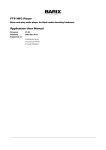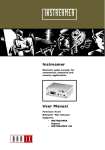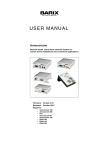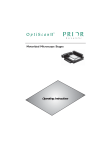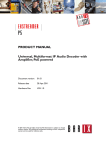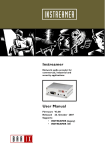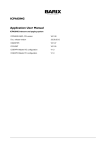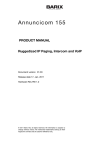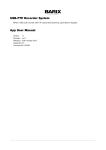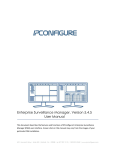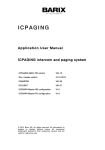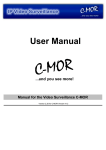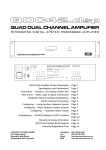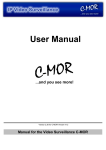Download ANY TO ALL PA SYSTEM
Transcript
A N Y T O A L L PA S Y S T E M Application User Manual Application version V2.01 Released 19. Dec. 2014 Supports: Annuncicom family (send/receive audio) Exstreamer family (receive audio) © 2014 Barix AG, all rights reserved. All information is subject to change without notice. All mentioned trademarks belong to their respective owners and are used for reference only. Table of Contents 1 Introduction...............................................................................5 1.1 About the “Any to all PA system”...............................................5 1.2 Installing the device....................................................................6 1.3 Additional documents.................................................................6 1.4 Preloaded Firmware....................................................................6 1.5 About this manual.......................................................................7 1.5.1 Links to chapters..............................................................7 1.5.2 Links to the Dictionary......................................................7 1.5.3 Bookmarks pane in Adobe Acrobat..................................7 2 Any to All PA system Description............................................8 2.1 IDLE mode..................................................................................8 2.2 RECEIVE mode...........................................................................8 2.3 TRANSMIT mode........................................................................9 2.4 Hardware:.................................................................................10 2.4.1 Encoder..........................................................................10 2.4.2 Decoder..........................................................................10 2.5 Audio format.............................................................................10 2.6 Latency.....................................................................................11 3 Device Status and Control.....................................................12 3.1 Web UI......................................................................................12 3.2 HOME page:.............................................................................13 3.3 CONFIGURATION Page...........................................................15 3.3.1 Basic Settings.................................................................16 3.3.2 Advanced Settings..........................................................17 3.3.3 Applying or Discarding Settings......................................22 4 X8 to Annuncicom Wiring.......................................................23 4.1 Introduction .........................................................................23 4.2 Annuncicom DB9 pinout...........................................................23 4.3 Connection using COM1..........................................................24 4.4 Connection using COM 2.........................................................25 5 Updating the device................................................................26 6 Dictionary................................................................................27 6.1.1 DHCP .............................................................................27 6.1.2 IP ....................................................................................27 6.1.3 IPzator ............................................................................27 6.1.4 MAC address..................................................................27 6.1.5 Netmask..........................................................................28 6.1.6 Ping ................................................................................28 6.1.7 Static IP..........................................................................28 6.1.8 Telnet..............................................................................28 7 IP Address, Netmask etc........................................................29 7.1.1 IP Addressing..................................................................29 7.1.2 Class A network..............................................................29 7.1.3 Class B network..............................................................29 7.1.4 Class C network..............................................................30 7.1.5 Class D network..............................................................30 7.1.6 Class E network..............................................................30 7.1.7 Network Address............................................................30 7.1.8 Broadcast Address.........................................................30 7.1.9 IP Netmask.....................................................................31 7.1.10 Private IP Networks and the Internet............................32 7.1.11 Network RFC’s..............................................................32 8 Legal Information....................................................................33 Application User Manual “Any to All PA system“ - V2.01 - 19. Dec. 2014 1 1.1 Introduction About the “Any to all PA system” This is a BCL application to stream audio from any one of a number of locations to all / selected destinations. Selection of destinations is achieved by input switches. Audio is unidirectional, from the sender to selected destinations i.e. a PA implementation. Features: • The system supports a maximum of 16 individual locations, using Annuncicom Family hardware with an optional X8 module attached. • Barix Exstreamer devices can also be used as 'Receive only' endpoints in the system. • One input can be defined to mean 'stream to all destinations'. • The application supports a web UI with configuration and status information. • Application is supplied with source code and can be modified by users, if desired. • Supports RTP streaming protocol • Uses mp3, uLaw or aLaw audio format • Supports unicast, multiple unicasts, multicast and broadcast addressing Introduction 5 Application User Manual “Any to All PA system“ - V2.01 - 19. Dec. 2014 1.2 Installing the device For the physical installation of the Annuncicom hardware, please refer to the corresponding “Quick Install Guide”. A printed version is included in the box and can also be downloaded from our site www.barix.com. The wiring of the X8 modules is detailed later in this document. 1.3 Additional documents Technical specifications can be found in the corresponding product sheet which can be downloaded from our site www.barix.com. For detailed technical information about the BCL programming language please download the “Barix Control Language (BCL) Programmers Manual” from our website. The Simple PA system application is delivered with its source code: if you wish to modify it, you can do so. 1.4 Preloaded Firmware Barix preloads all Annuncicom and Exstreamer devices with standard applications. In order to use the 'Any to all PA Application', you will first need to load it into all devices in the system, by following the instructions in the “_readme1st” document included in the application download. NOTE: this is an ABCL application, developed on Barix' open development platform, it uses the ABCL standard web interface; status information is reported in the main ‘HOME’ tab, configuration options for this application, or options relating to the device/network configuration are found by clicking on the 'CONFIGURATION' tab. 6 Introduction Application User Manual “Any to All PA system“ - V2.01 - 19. Dec. 2014 1.5 About this manual 1.5.1 Links to chapters References to chapters (e.g. X Chapter name) are red and underlined and serve as direct links when viewed in Adobe Acrobat Viewer. Click on the link to jump to the referenced chapter, click on the left arrow icon to jump back to where you came from. 1.5.2 Links to the Dictionary Some technical terms (e.g. DHCP) are underlined and red. Click on them to jump to the dictionary at the end of this manual, click on the left arrow icon to jump back. 1.5.3 Bookmarks pane in Adobe Acrobat The complete “Table of Contents” is available in Adobe Acrobat Viewer. Click on the “Bookmarks” pane tab on the left side of Adobe Acrobat Viewer to open it. Click on any bookmark to directly jump to the corresponding part of the manual. Introduction 7 Application User Manual “Any to All PA system“ - V2.01 - 19. Dec. 2014 2 Any to All PA system Description The Any to All PA system is an ABCL application, as such its user interface is based upon the ABCL standard; hardware/network general settings configured in the 'CONFIGURATION' section, application specific behaviour under main 'HOME' tab (index page). See chapter 3.1 for more detail. The system has 3 distinct modes in operation: IDLE, RECEIVE and TRANSMIT, depending upon whether the system is currently inactive, has an incoming audio stream, or is sending audio to other destinations. 2.1 IDLE mode If none of the input switches are active, the system is in IDLE mode. Idle is used to mean not actively sending or receiving audio; the system is not doing nothing. In IDLE mode the device listens to a UI-configurable UDP Send/Receive socket for an RTP stream. On detecting an RTP stream on the specified port whilst in IDLE mode, it will enter RECEIVE mode. If an input switch becomes active when the device is in IDLE mode, the device will enter TRANSMIT mode. 2.2 RECEIVE mode On entering RECEIVE mode, the device plays the received stream, any input switch changes will be ignored on this device: only one device in the system can TRANSMIT at any time, all others (that are addressed) must RECEIVE. 8 Any to All PA system Description Application User Manual “Any to All PA system“ - V2.01 - 19. Dec. 2014 If so configured, the device will set its relay active whilst receiving a stream. This relay signalisation is intended to enable control of attached equipment, such as an amplifier, at the remote end. The status page will show a status of 'RECEIVING' and the details of the source stream. 2.3 TRANSMIT mode When the device is in Idle mode, activating one or more of the attached inputs will cause the device to look up the destination configured for the activated input(s) and start sending audio to the configured target(s), using the defined Send/Receive port. The Audio input source can be from Line In, or the microphone input, configurable via the web UI, as are the targets for the input switches. The first input to go active sets the destination and starts the audio stream, if more inputs become active whilst the device is streaming, then the stream is also sent to the corresponding destination(s). If an input is deactivated during streaming (whilst the device is in TRANSMIT mode), then the audio is no longer streamed to the destination(s) associated to that input. The device stays in TRANSMIT mode sending audio for as long as any of the inputs are active. Any to All PA system Description 9 Application User Manual “Any to All PA system“ - V2.01 - 19. Dec. 2014 2.4 Hardware: There are several possible Barix devices that can run the application. 2.4.1 Encoder In order to operate as an audio source, the Barix device must be an encoder, with GPIs: it is intended for use with the Annuncicom family, specifically the Annuncicom 100, with an X8 extension module attached to provide the necessary number of GPIs. If used, the X8 must be operated in "standard" (default) mode (Modbus/RTU). X8 connection is available by both COM1(rs232) and COM2 (rs485). 2.4.2 Decoder The application may also be run on an Exstreamer family device, where it will support Receiving of audio only, not Sending. For the Exstreamer family devices with LCD display, the LCD displays the application name, version and device IP in IDLE state, and “Stream From : INCOMING_IP” when a stream is received, or “Streaming” when in TRANSMIT mode. 2.5 Audio format ◦ The device encodes in MPEG or G.711(µ-Law, a- Law) format. ◦ When using MP3, different Quality levels are supported (0 -7) – this affects how much data is transmitted over the network (0 is lower quality; so requires less network bandwidth, 7 is highest quality, and needs more). 10 Any to All PA system Description Application User Manual “Any to All PA system“ - V2.01 - 19. Dec. 2014 ◦ When using MPEG, sample rates of 16, 22.05, 24, 32, 44.1 and 48 kHz are supported, while using G.711 format (µ-Law / a-Law), 8 and 24 kHz sample rates are available. The sample rate is how often the signal is measured. A lower sample rate has two obvious consequences: first, it means that the signal is examined less often, so less data about the audio is collected, requiring less network bandwidth to transmit it. Second, because the signal is sampled less often, the 'precision' of the audio is less than at higher sample rate: it will sound less good. (Consider: the standard for fixed line telephony was 8 kHz, mp3 music files typically use 48 kHz) 2.6 Latency System latency – the delay in transmitting the audio from Sender to playback at the receiver – has many factors: ◦ The principal user-controllable factor affecting system latency is the size of the receive buffer (in milliseconds): decrease the size to reduce the delay, but beware of reducing it too low as this will expose the system to audio dropouts due to network jitter. ◦ the sample rate and encoding quality affect how much data is sent: the more data being sent, the quicker the receive buffer is filled, the faster the receiver starts playing the audio. ◦ the physical topology of the network: is it local, or remote, and the type/bandwidth of the connections and so forth will determine the network jitter. A system latency in the range 200-500ms is considered acceptable for this application. Any to All PA system Description 11 Application User Manual “Any to All PA system“ - V2.01 - 19. Dec. 2014 3 3.1 Device Status and Control Web UI The application provides a web UI based on the ABCL standard interface: Illustration 1: Default application web page on Annuncicom 100 12 • HOME: Information of the current state of the application are found under the 'HOME' tab; this is the default page when the device restarts, refer to chapter 3.2 HOME page: • CONFIGURATION: Data and options relating to the Hardware (Network, Serial port configuration and Device Status and Control Application User Manual “Any to All PA system“ - V2.01 - 19. Dec. 2014 Security) and to the application are found under the ‘CONFIGURATION’ tab, refer to chapter 3.3 CONFIGURATION Page . 3.2 • STATUS: Clicking on this tab, a page displays in a report all the device, application status and application configured parameters. • Defaults: Clicking on the 'Defaults' tab allows the user to reset the application factory default settings, with the exception of the Network settings (needed for ongoing communication!). The device will reboot. • Reboot: allows the user to force a reboot of the device. • Update: Enters the web update mechanism, allowing the device firmware to be updated. Refer to the “readme1st” file in the application package for full details. HOME page: All aspects of the application are defined here. Note: the displayed data is updated every second. APPLICATION STATUS section • State: the current state of the device; Idle, Receive, Transmit. When in Receive state, the sender IP is displayed. • X8 Extension : whether an X8 extension module has been detected, or not. I/O STATES section • Device Inputs: the states of the GPIs are represented here; Inactive states are shown grey, unavailable GPIs are shown white, active GPIs are shown in yellow. • X8 Inputs : whether a X8 extension module has been detected, states of the X8 GPIs are represented here; Inactive states are shown grey, unavailable GPIs are Device Status and Control 13 Application User Manual “Any to All PA system“ - V2.01 - 19. Dec. 2014 shown white, active GPIs are shown in yellow. If the X8 is not connected GPIs are shown white. Note: whether a PS16 is used, these GPIs, from 1 to 8, represents respectively PS16 keys 9 to 16. • Relay State: the relay 1 can be controlled by the application, the current state at the time of the page load is shown here. Either 'Open', as grey box, or 'Activated' as yellow box. On devices where Relay is not available, a white box is shown. STREAMING DETAILS section 14 • Decoding Audio Format: the auto-detected incoming stream audio format. The audio format is recognized from the incoming RTP ‘payload type’ field. • Encoding Audio Format: the current configured encoding audio format. • Average Bitrate: the bitrate in kbps of the INCOMING stream. • RX Buffer Level: the amount of data in the INPUT buffer, in bytes, from 0 to 32768. • Current Volume: Current volume level, from 0 to 100%, as 5% steps. • Input Level: the audio input level on the configured input source. Absolute linear value, from 0 – 32768. • Output Level: the audio output level. Absolute linear value, from 0 – 32768. • RTP Lost Frames: number of lost frames during decoding. The value is reset with every new RTP sequence. • RTP Duplicated Frames: number of duplicated frames during decoding due to the buffer management. Frames are duplicated if encoder is slower than decoder. • RTP Dropped Frames: number of dropped frames Device Status and Control Application User Manual “Any to All PA system“ - V2.01 - 19. Dec. 2014 during decoding due to the buffer management. Frames are dropped if encoder is faster than decoder. 3.3 CONFIGURATION Page Clicking on the UI 'CONFIGURATION' tab will cause the browser to display the general configuration page; this is where both application options and device-specific settings can be configured. This page is divided in several sections: the ‘Basic Settings’ left menu link allows a quick setup-and-go of the application, while the ‘Advanced Settings’ displays all the application and device-specific settings, separating every functionality in a specific dedicated section. Device Status and Control 15 Application User Manual “Any to All PA system“ - V2.01 - 19. Dec. 2014 Illustration 2: Settings page for configuring application or device-specific parameters. 3.3.1 Basic Settings Basic settings, for a fast configuration of the PA system. Streaming sockets (IP and ports) can be configured here. Target Table This table allows to use digital inputs to start and stop streaming to a destination. For every available input is possible to configure a destination socket (IP:PORT). IP as 0.0.0.0, or a port value set to 0, 16 Device Status and Control Application User Manual “Any to All PA system“ - V2.01 - 19. Dec. 2014 mean "no target". Unicast, or multicast IP addresses can be used here. By having a destination address of 255.255.255.255 configured against an input, the device will stream to ALL destinations configured in the target table when that input is activated. The streams will be sent UNICAST to each destination. Note: on Barix PS16 Paging Station the 16 destinations corresponds, from n. 1 to 16, to PS16 keys 1 to 16. [default: 0.0.0.0 : 0] Receiving Socket Audio stream receiving socket (IP:PORT). Use 0.0.0.0 (default) to listen to any IP or use a multicast IP to join a multicast group. [default: 0.0.0.0 : 3030] 3.3.2 Advanced Settings Advanced settings, for detailed configuration of every behavior of the PA system. Network section Network Settings This section allows the configuration of the following device settings: • • • • • • • • IP address Netmask Gateway DNS Syslog message destination server: if unset (default, set to 0.0.0.0) syslog messages are broadcasted DHCP hostname WEB server listening port Default Ethernet Port (Annuncicom 1000 only) Device Status and Control 17 Application User Manual “Any to All PA system“ - V2.01 - 19. Dec. 2014 Streaming section Target Table This table allows to use digital inputs to start and stop streaming to a destination. For every available input is possible to configure a destination socket (IP:PORT). IP as 0.0.0.0, or a port value set to 0, mean "no target". Unicast, or multicast IP addresses can be used here. By having a destination address of 255.255.255.255 configured against an input, the device will stream to ALL destinations configured in the target table when that input is activated. The streams will be sent UNICAST to each destination. Note: on Barix PS16 Paging Station the 16 destinations corresponds, from n. 1 to 16, to PS16 keys 1 to 16. [default: 0.0.0.0 : 0] Receiving Socket Audio stream receiving socket (IP:PORT). Use 0.0.0.0 (default) to listen to any IP or use a multicast IP to join a multicast group. [default: 0.0.0.0 : 3030] RTP delay The RTP decoder keeps constant decoding latency within one frame accuracy. Set the required delay in milliseconds. To synchronize multiple receivers to the same stream, set all to the same value. The delay value should be set large enough to cope with network jitter (difference in packets delivery time) and possible packet loss. Increase the value if you are experiencing audio dropouts. 18 Device Status and Control Application User Manual “Any to All PA system“ - V2.01 - 19. Dec. 2014 Audio format µ/a-Law 8kHz mono µ/a-Law 24kHz mono MPEG Quality 0 16kHz MPEG Quality 0 22,05kHz MPEG Quality 0 24kHz MPEG Quality 0 32kHz MPEG Quality 0 44,1kHz MPEG Quality 0 48kHz Rec. Max. 444 4076 188 1345 883 (*) 658 (*) 646 (*) 478 (*) 392 (*) 384 (*) (*) For more details about the RTP settings please visit the RTP Buffering on Barix Wiki. [default: 500msecs] Audio section Output Volume Selects the desired output volume, from 0% to 100%, in 5% steps. [default: 50%] Input Source Selects the desired mono input source, as Line or Microphone input. [default: Mic] Microphone Gain If Mic input source has been selected, this field selects the microphone input gain, in dB. [default: 21db] A/D Amplifier Gain Selects the Analog to Digital circuit gain, in dB. If Device Status and Control 19 Application User Manual “Any to All PA system“ - V2.01 - 19. Dec. 2014 Mic input source is selected this gain is added to the microphone gain. [default: 0dB] Audio Format Selects the desired PA system audio format. [default: MPEG] MPEG Encoding Quality If MPEG audio format is selected, selects the desired MPEG encoding quality. An higher value mean a lower compression. [default: 0] Sample Rate Selects the desired sample rate. [default: 32Khz] I/O section X8 Connection Port Selects the desired device serial port where to connect the Barix X8 extension. Each serial port is preconfigured to connect to the X8 extension, when X8 is configured with the default serial communication parameters. COM1 allows to connect the X8 using a rs232 to rs485 adapter COM2 allows to connect the X8 using real rs485 protocol. See next chapter 4 for further information on the X8 connection wiring. [default: COM1] Relay Action Selects the desired relay behavior. [default: Active on Listen] 20 Device Status and Control Application User Manual “Any to All PA system“ - V2.01 - 19. Dec. 2014 Security section Security Settings This section allows to configure the device password and other security settings. Reset Function Enable or disable the "Reset" function on the Reset button and on the WEB UI. In order to restart the device press the Reset button once. Default: "enabled" Factory Defaults Enable or disable the "Factory Defaults" function on the Reset button. In order to revert all settings to factory defaults keep the Reset button pressed until the red LED starts blinking (approx. 10 seconds). Default: "enabled" Update Function Enable or disable the WEB Update function of the device. If the Update function is disabled, the only way to update the firmware is to use the serial rescue. Default: "enabled" Set Password This is visible as long as no password is set. Enter a password (up to 25 characters) and hit the "Apply" button. After the restart you should close the browser window and open a new browser window. You will be asked to supply user name and password. The user name can be omitted but the password has to be supplied in order to see the web configuration. Old Password / New Password These fields are visible as long as a password is set. To allow free access (clearing the password) enter the old password and leave the field "New Password" empty. Enter the old password in the password field above the "Apply" button as well and Device Status and Control 21 Application User Manual “Any to All PA system“ - V2.01 - 19. Dec. 2014 then hit the "Apply" button. After the restart you will not be asked for user name and password anymore. To change the password enter the old password and enter the new password in the field "New Password". After the restart you will be asked for user name and password. The user name can be omitted but the new password has to be supplied in order to see the web configuration. 3.3.3 22 Applying or Discarding Settings After the parameters has been set, click on “Apply” button in the left side of the page, the device will reboot with new parameters set. Click on “Cancel” to return back to the current set parameters. Device Status and Control Application User Manual “Any to All PA system“ - V2.01 - 19. Dec. 2014 4 4.1 X8 to Annuncicom Wiring Introduction The Annuncicom 100/200 devices have two COM ports available, COM1 and COM2. Both COM ports are physically connected to the DB9 connector on the front panel of the device. COM1 is RS232 COM2 is RS485 When connecting an X8 Input extension device, either port can be used. The X8 uses RS485 to communicate, hence if using COM1 on the Annuncicom, a special adapter cable must be made. NOTE: for details of how to wire the X8 with inputs, refer to the X8 documentation, available from www.barix.com 4.2 Annuncicom DB9 pinout 1. Not connected 2. RS232 receive data (RxD) 3. RS232 transmit data (TxD) 4. Vcc +14,6V 100mA max 5. GND 6. RS485 Wire A 7. Ready To Send (RTS) 8. Clear To Send (CTS) 9. RS485 Wire B X8 to Annuncicom Wiring 23 Application User Manual “Any to All PA system“ - V2.01 - 19. Dec. 2014 4.3 Connection using COM1 In order to use COM1 on the Annuncicom with the X8, construct the connector cable as shown below. X8 J3 Front DB9 1 2 2.7 kOhm 3 2 2.7 kOhm 3 4 4 5 5 24 X8 to Annuncicom Wiring Application User Manual “Any to All PA system“ - V2.01 - 19. Dec. 2014 4.4 Connection using COM 2 Using COM2, a standard RS485 cable should be wired as follows: X8 J3 Front DB9 2 6 3 9 4 4 5 5 X8 to Annuncicom Wiring 25 Application User Manual “Any to All PA system“ - V2.01 - 19. Dec. 2014 5 Updating the device Barix preloads all Annuncicom and Exstreamer devices with firmware which is current at the day of production, however Barix constantly enhances the capabilities and functions and recommends to keep the firmware on the device up-to-date. Barix recommends the use of the “Update over network” method to update the firmware using TFTP. We strongly recommend use of the supplied batch files which are included in the “Update Kit” to perform a serial update, especially the first time that the application is loaded onto each device. If the network update is interrupted during the process (power or network loss) the device might become unreachable. In that case the “Serial Rescue” procedure is the only remedy. Please keep that in mind when planning a remote “Update over network”. 26 Updating the device Application User Manual “Any to All PA system“ - V2.01 - 19. Dec. 2014 6 6.1.1 Dictionary DHCP Short for Dynamic Host Configuration Protocol, a protocol used to assign an IP address to a device connected to a Network. 6.1.2 IP Short for Internet Protocol, the IP is an address of a computer or other network device on a network using IP or TCP/IP. Every device on an IP-based network requires an IP address to identify its location or address on the network. Example: 192.168.2.10 See also chapter 7 IP Address, Netmask etc. 6.1.3 IPzator Barix IPzator™ technology is designed for the purpose that the Barix device can create its own IP address according to the network structure in case it can’t receive one from your network. If DHCP, AUTOIP or BOOTP fail, IPzator will create an IP address within the subnet and test it (starting with x.x.x.168 and if occupied incrementing by one). If the address works and is not being used by another device on the network, it will give the address to the Barix device. 6.1.4 MAC address Abbreviation for Medium Access Control, a MAC is a unique address number formatted in hexadecimal format and given to each computer and/or network device on a computer network. Because a MAC address is a unique address a computer network will not have the same MAC address assigned to more than one computer or network device. Example: A1:B2:C3:D4:E5:F6 Dictionary 27 Application User Manual “Any to All PA system“ - V2.01 - 19. Dec. 2014 6.1.5 Netmask A number used to identify a sub network so that an IP address can be shared on a LAN (Local Area Network). A mask is used to determine what subnet an IP address belongs to. An IP address has two components, the network address and the host address. For example, consider the IP address 150.215.017.009. Assuming this is part of a Class B network, the first two numbers (150.2.) represent the Class B network address, and the second two numbers (.017.009) identify a particular host on this network. The Netmask would then be 255.255.0.0 . See also chapter 7 IP Address, Netmask etc. 6.1.6 Ping Ping is a basic Internet program that lets you verify that a particular IP address exists and can accept requests. Example: ping 192.168.2.10 6.1.7 Static IP A Static IP is a fixed IP address that you assign manually to a device on the network. It remains valid until you disable it. 6.1.8 Telnet Telnet is an user command and an underlying TCP/IP protocol for accessing remote computers. On the Web, HTTP and FTP protocols allow you to request specific files from remote computers, but not to actually be logged on as a user of that computer. With Telnet, you log on as a regular user with whatever privileges you may have been granted to the specific application and data on that computer. Example: telnet 192.168.2.10 28 Dictionary Application User Manual “Any to All PA system“ - V2.01 - 19. Dec. 2014 7 7.1.1 IP Address, Netmask etc. IP Addressing An IP address is a 32 bit value, divided into four octets of eight bits each. The standard representation is four decimal numbers (in the range of 0..255), divided by dots. • Example: 192.2.1.123 This is called decimal-dot notation. The IP address is divided in two parts: a network and a host part. To support different needs, five ”network classes” have been defined. Depending on the network class, the last one, two or last three bytes define the host, while the remaining part defines the network. In the following text, ‘x’ stands for the host part of the IP address. 7.1.2 Class A network • IP address 1.x.x.x to 127.x.x.x Only 127 different networks of this class exist. These have a very large number of potential connected devices (up to 16'777'216) • Example: 10.0.0.1 (network 10, host 0.0.1) 7.1.3 Class B network • IP address 128.0.x.x to 191.255.x.x These networks are used for large company networks. Every network can consist of up to 65534 devices. • Example: 172.1.3.2 (network 172.1, host 3.2) IP Address, Netmask etc. 29 Application User Manual “Any to All PA system“ - V2.01 - 19. Dec. 2014 7.1.4 Class C network • IP address 192.0.0.x to 223.255.255.x Class C networks are most common and for smaller companies. These networks can consist of a maximum number of 254hosts. • Example: 192.7.1.9 (network 192.7.1, host 9) 7.1.5 Class D network The remaining addresses 224.x.x.x - 239.x.x.x are defined as ”Class D” and are used as multicast addresses. 7.1.6 Class E network No addresses are allowed with the four highest order bits set to “1” (240.x.x.x – 254.x.x.x). These addresses, called "class E", are reserved. 7.1.7 Network Address The host address with all host bits set to "0" is used to address the network as a whole (for example in routing entries). • Example: 192.168.0.0 Network addresses can not be used as a host address! 7.1.8 Broadcast Address The address with the host part bits all set to ”1” is the broadcast address, meaning ”for every host”. • Example: 192.168.0.255 Broadcast addresses can not be used as a host address! 30 IP Address, Netmask etc. Application User Manual “Any to All PA system“ - V2.01 - 19. Dec. 2014 7.1.9 IP Netmask The Netmask is used to divide the IP address differently from the standard defined by the classes A,B and C. Entering a Netmask, it is possible to define how many bits from the IP address are to be taken as the network part and how many bits are to be taken as the host part. Standard IP network Netmask: Class A B C Network bits 8 16 24 Host bits 24 16 8 Netmask 255.0.0.0 255.255.0.0 255.255.255.0 Netmask examples: Netmask 255.255.255.252 255.255.255.248 255.255.255.240 255.255.255.224 255.255.255.192 255.255.255.128 255.255.255.0 255.255.254.0 255.255.252.0 255.255.248.0 . . 255.128.0.0 255.0.0.0 2 3 4 5 6 7 8 9 10 11 . . 23 24 Host bits IP Address, Netmask etc. 31 Application User Manual “Any to All PA system“ - V2.01 - 19. Dec. 2014 7.1.10 Private IP Networks and the Internet If your network is not connected to the Internet and there are no plans to make such a connection you may use any IP address you wish. However if you are not connected to the Internet and have plans to connect to the Internet or you are connected to the Internet and want to operate your Barix Barionet on an intranet you should use one of the sub-networks below for your network. These network numbers have been reserved for such networks. If you have any questions about IP assignment ask your Network Administrator. Private IP networks by class: Class A B C 7.1.11 32 Network 10.x.x.x 172.16.x.x 192.168.0.x Network RFC’s For more information regarding IP addressing see the following documents. They can be found on the Internet: IP Address, Netmask etc. Application User Manual “Any to All PA system“ - V2.01 - 19. Dec. 2014 8 Legal Information © 2014 Barix AG, Zurich, Switzerland. All rights reserved. All information is subject to change without notice. All mentioned trademarks belong to their respective owners and are used for reference only. Barix, Exstreamer, X8 and Annuncicom are trademarks of Barix AG, Switzerland and are registered in certain countries. For information about our devices and the latest version of this manual please visit www.barix.com. Barix AG Seefeldstrasse 303 8008 Zürich SWITZERLAND T F +41 43 433 22 11 +41 44 274 28 49 www.barix.com [email protected] [email protected] Legal Information 33


































